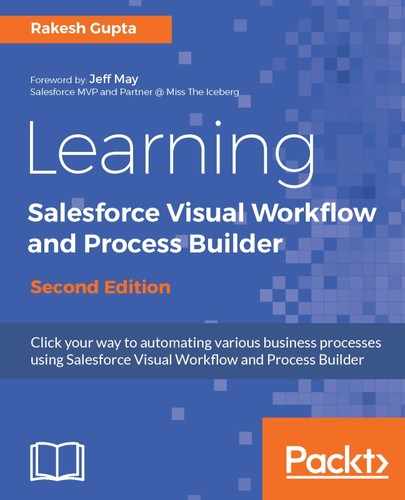The following are some noteworthy points regarding data manipulation in a Flow:
- Make sure that the field is set as Input and Output to pass values from the controller.
- Use the <apex:param> component in the Visualforce page to set the variables' value.
- Use the start() method in the Flow.Interview class to call a Flow from a controller.
- Using the standard list controller, you can set the SObject Collection Variable value from the standard controller.
- If you have embedded a Flow into a Visualforce page and Flow is not activated, then at runtime, Flow users will receive an error.
- Once you have deactivated a Flow, you can immediately delete it.
- If you are using the same choice in multiple screens on a Flow and you want to find the recent one, then use was selected in your query.
- To set the record type for a record, use the record type ID.
- If the Flow Designer doesn't show the custom object or fields you recently created, then close the Flow Designer and reopen it.
- If the Flow Designer doesn't show custom object or fields, make sure that you have permission to access it via a profile.
- Remember that Visual Workflow runs in the user mode.
- You can distribute a Flow through a package and deploy it through change sets.
- You can't redirect a Flow user to a URL that is external to your Salesforce organization.
- You can save 50 versions of a Flow, only one of which can be active.
- Don't forget to grant Visualforce page access to your Flow users, or else they may receive an error at runtime.
- The Flow or Process are using the AllOrNone header, which means if the runtime error occurs, Salesforce will roll back records because not all records were valid.
- The following relationships are not supported in cross-object field references:
- Lead.ConvertedAccount
- Lead.ConvertedContact
- Lead.ConvertedOpportunity
- Cross-object field references in Flows do not count against your organization's limits for the following:
- Cross-object relationships per object
- DML operations per transaction
- If a Flow interview encounters a null value at any point in the cross object reference, the element containing the reference fails at runtime. The reference runs successfully if the last field value in the expression is null. For example, store an opportunity in {!SovOpportunity} and try to reference {!SovOpportunity}.Account.Name. The Flow will fail at runtime if Account ID on the stored opportunity is null (because there isn’t an account to look at), but it succeeds if the name on the related account is null.
- If you are planning to set a value for a read-only field, then make sure that you are aware of its limitations. Refer to this help article for a detailed explanation: https://help.salesforce.com/articleView?id=vpm_admin_inaccessiblefields_behavior.htm&language=en_US&type=0
